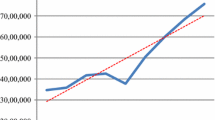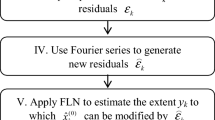Abstract
This study provides a flexible and mathematically precise method for forecasting tourism demand from all five continents of the globe to Taiwan and with potential to assist tourism operators and government officials in improving their management planning and strategy. This investigation applied the Grey Envelop Prediction Model (GEPM) to predict international passenger arrivals to Taiwan. The analysis result shows monthly, seasonal and annual predictions. The prediction values of international tourist numbers can answer the practical needs of managers, owners, and government departments and help in operational and management strategy development. The contributions of this study is provides an effective method for forecasting number of international visitors, and the result provided the flexible, accurate, and efficient interval predicted values used by researchers, mangers and administrators for developing manpower, finance, marketing, and administrative decision-making schemes.
Similar content being viewed by others
References
Burger C.J.S.C., Dohnal M., Kathrada M., Law R.: A practitioners guide to time-sequence methods for tourism demand forecasting: a case study of Durban, South Africa. Tour. Manag. 22, 403–409 (2001)
Crouch G.: A Meta-analysis study of international tourism demand. Ann. Tour. Res. 22, 103–118 (1995)
Deng J.L.: Grey Prediction and Grey Decisio. 2nd edn. Huazhong University of Science Technology Press, China (2002)
Fritz R., Brandon C., Xander J.: Combining time sequence and econometric forecast of tourism activity. Ann. Tour. Res. 11, 219–229 (1984)
Hilas C.S., Goudos S.K., Sahalos J.N.: Seasonal decomposition and forecasting of telecommunication data: a comparative case study. Technol. Forecast. Soc. Chang. 73, 495–509 (2006)
Hsu L.C.: Applying the Grey prediction model to the global integrated circuit industry. Technol. Forecast. Soc. Chang. 70, 563–574 (2003)
Lee J., Cho Y., Lee J.D., Lee C.Y.: Forecasting future demand for large-screen television sets using conjoint analysis with diffusion model. Technol. Forecast. Soc. Chang. 73, 362–376 (2006)
Lee C.Y., Lee J.D., Kim Y.: Demand forecasting for new technology with a short history in a competitive environment: the case of the home networking market in South Korea. Technol. Forecast. Soc. Chang. 75, 91–106 (2008)
Lee C.F., Lin S.J., Lewis C., Chang Y.F.: Effects of carbon taxes on different industries by fuzzy goal programming: a case study of the petrochemical-related industries, Taiwan. Energy Policy 35, 4051–4058 (2007)
Li G., Song H., Witt S.F.: Time varying parameter and fixed parameter linear AIDS: an application to tourism demand forecasting. Int. J. Forecast. 22, 57–71 (2006)
Lin C.T., Yang S.Y.: Forecast the output value of Taiwan’s optoelectronics industry using the grey forecasting model. Technol. Forecast. Soc. Chang. 70, 177–186 (2003)
Lin C.T., Yang S.Y.: Forecast of the output value of Taiwan’s IC industry using the grey forecasting model. Int. J. Comput. Appl. Technol. 19, 23–27 (2004)
Oh C.O., Morzuch B.J.: Evaluating time-sequence models to forecast the demand for tourism in Singapore. J. Travel Res. 43, 404–413 (2005)
Preez J.D., Witt S.F.: Univariate versus multivariate time sequence forecasting: an application to international tourism demand. Int. J. Forecast. 19, 435–451 (2003)
Riddington G.L.: Forecasting ski demand: comparing learning curve and varying parameter coefficient approaches. J. Forecast. 18, 205–214 (1999)
Sheldon P.J., Var T.: Tourism forecasting: a review of empirical research. J. Forecast. 4, 183–195 (1985)
Song, H., Li, G.: Tourism demand modeling and forecasting: a review of recent research. Tour. Manag. (2007). doi:10.1016/j.tourman.2007.07.016
Triantafyllopoulos K.: Covariance estimation for multivariate conditionally Gaussian dynamic linear models. J. Forecast. 26, 551–569 (2007)
Wang S.M., Lin C.T.: The lowest supply and demand of engineering officers of national vessels in Taiwan. Qual. Quant. 41, 19–36 (2007)
Witt S.F., Witt C.A.: Forecasting tourism demand: a review of empirical research. Int. J. Forecast. 11, 447–475 (1995)
Wong K.K.F., Song H., Witt S.F., Wu D.C.: Tourism forecasting: to combine or not to combine? Tour. Manag. 28, 1068–1078 (2007)
Xiao D.Q., Ma R.G.: Traffic volume forecasting with surrounding grey GM(1,1). Technol. Econ. Areas Commun. 6, 53–55 (2005)
Author information
Authors and Affiliations
Corresponding author
Rights and permissions
About this article
Cite this article
Huang, YL., Lin, CT. Developing an interval forecasting method to predict undulated demand. Qual Quant 45, 513–524 (2011). https://doi.org/10.1007/s11135-010-9317-9
Published:
Issue Date:
DOI: https://doi.org/10.1007/s11135-010-9317-9




